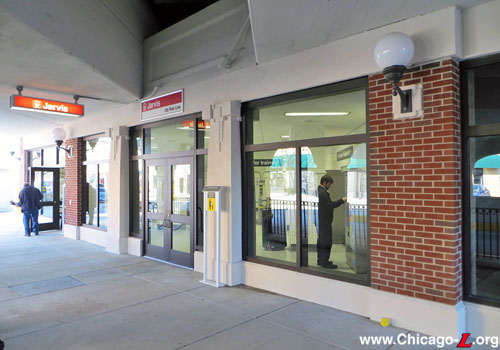
The front entrances of Jarvis station, looking southeast on December 14, 2012, the first full day the station was open after renovation. The pilasters framing the main entrance doors and the ornamentation around the light fixtures convey the station's Prairie School influences. The windows and door in the last bay in the background were previously a separate retail space adjacent to the station, now integrated into the expanded station house footprint. For a larger view, click here. (Photo by Graham
Garfield) |
Jarvis
(7400N/1600W)
Jarvis Avenue between Ashland
Avenue and Greenview Avenue, Rogers Park
Service
Notes:

|
Red Line:
Howard |

|
Owl
Service |
Quick Facts:
Address: 1523-25 W. Jarvis
Avenue
Established: May 16, 1908
Original Line: Northwestern Elevated Railroad
Previous Names: Birchwood
|
Skip-Stop Type:
|

|
Station
|
Rebuilt: 1921, 2012
Status: In Use
History:
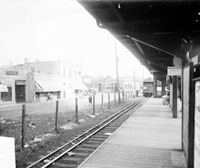
The Birchwood station is seen looking southeast on the platform toward the station house and Bryan Avenue in 1913 as a train departs toward the Loop. For a
larger view, click here [off-site link]. (DN-0061524, Chicago Daily News negatives collection, Chicago History Museum, courtesy of the Library of Congress) |
"L" service first entered north Chicago and Evanston by way of an
agreement to use the tracks of the Chicago, Milwaukee and St. Paul
Railway's tracks, replacing the steam service that
the St. Paul had previously provided. The Chicago City Council
authorized the electrification of the tracks of the Chicago,
Milwaukee and St. Paul Railroad's tracks from Graceland Avenue
(Irving Park Road) to the city limits on July 1, 1907. Unlike Evanston (as per the 1907 franchise agreement from the city),
the Chicago City Council did not require that the grade-level tracks
be elevated, but they did prohibit the use of a third rail for
safety's sake, necessitating the use of overhead trolley wire. "L" service north of Wilson to Central Avenue in Evanston began on May 16, 1908.
The St. Paul had a station named Birchwood at Bryan Avenue (later renamed Jarvis Avenue) between Ashland Avenue and Perry Avenue (later Greenview Avenue). The station, of a style typical of railroad depots, was located on the east side of the tracks on the north side of Bryan. Although a Birchwood Avenue is located two blocks north of the station, the stop was not named for the street, but rather for the local community. Samuel B. Chase, a developer of what became the Rogers Park neighborhood, named the subdivision between Birchwood and Touhy avenues east of the St. Paul tracks "Birchwood Beach," after his farm in the Lake View section of Chicago.1 The name "Birchwood" was adopted by local residents and businessmen to refer to this section of Rogers Park, and was utilized by the St. Paul railroad for their depot serving the area.
As they did at the other stations on the newly electrified line, the Northwestern Elevated Railroad chose not to use the station facilities of the St. Paul steam railroad, which were situated and designed for the needs of a main line commuter railroad rather than a rapid transit service. Instead, the Northwestern built a new station at the same location as the St. Paul's station. The "L" station facility at Birchwood was a
simple ground-level station and modest platform on the north side of Bryan Avenue. The station house was
a small, wood frame building set between the two tracks at ground
level with a wooden walkway and stairs leading up to it from the street. The
exterior used clapboard siding and a hipped roof with eaves. The rear
opened out onto an island platform. The platform had a short canopy with a hipped roof (which was actually a continuation of the station house's roof) and center wooden columns with angled brackets, and wood decking.
Track Elevation, a New Name, and a New Station
In the mid-1910s, the Northwestern Elevated began to elevate the
tracks north from Wilson to Howard, but
work was slow due to the city's refusal to close intersecting streets
and the narrow right-of-way. The elevation work involved complex staging and the temporary relocation of tracks to maintain service while building the new elevated embankment in the same right-of-way. In early 1916, trains were moved onto a
temporary trestle, allowing demolition of the original tracks and stations, but construction of a permanent embankment had to
wait until the end of World War I due to a materials shortage.
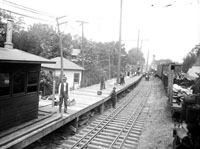
The Birchwood station is seen in 1915. Writing on the photo says the station is at Chase Avenue, suggesting this is the station relocated in 1915. Note the gauntlet track to allow freight trains to clear the platform; this is one of two locations in Rogers Park where there was not a separate third track for freight trains. The track and cars on the right may be part of the track elevation project. For a
larger view, click here [off-site link]. (DN-0064743, Chicago Daily News negatives collection, Chicago History Museum, courtesy of the Library of Congress) |
At midnight on July 1, 1915, the Birchwood station was relocated, apparently without warning and much to the dismay of the local residents and riders. The station's new location was variously cited as being at Chase Avenue, two blocks south of Jarvis2, and at Sherwin Avenue, one block south of Jarvis.3 It is unclear why the station was relocated -- it's relatively light-wight wood-frame construction would make such an overnight move possible -- although it may have been part of the staging necessary for the track elevation project. Interestingly, when the Chicago Daily Tribune contacted the general offices of the Northwestern Elevated, the "L" company claimed to not be aware of the move. "Don't know a thing about it," a man at the office told the newspaper. "They certainly would have advised us if they were going to move it."4 The "they" he referred to was presumably the Chicago, Milwaukee and St. Paul or their contractors, as the St. Paul still owned the line (the "L" leased it) and were the ones who undertook the design and construction of the track elevation project.
Other changes soon came to Birchwood station was well: On May 28, 1916, a local resident inquired to the Chicago Daily Tribune why conductors on the Northwestern Elevated trains had begun calling out the name of the station as "Jarvis Avenue-Birchwood" (suggesting that the stop had been relocated back to Jarvis Avenue by this time). The inquirer was seemingly displeased with the change, noting that "this district is fully established as Birchwood and business firms have adopted the name," and wanted to know what the permanent name of the station was to be. The Northwestern Elevated responded saying that "Jarvis Avenue" was added as a convenience to the public, many of whom were apparently confused by the name "Birchwood" referring to a district and not the street located two blocks north.5 By 1917, a year later, maps referred to the station simply as "Jarvis Ave.", making no mention of "Birchwood". By 1933, maps had dropped the "Ave." as well, simply calling the station "Jarvis" (as was common for most stations to not include the street type in the formal station name).
With the track elevation came a completely new station. The entrance to the "L" station was located on the south
side of Jarvis Avenue. The station had a design typical of the
facilities built as part of the Wilson-Howard elevation project.
Designed by architect Charles P. Rawson and engineered by C.F Loweth,
the architectural design was a Prairie School-influenced vernacular
form, with the Prairie influence seen most acutely in the ornamental
cement pilasters on the front facade and in the details of the wooden
doors, windows, and ticket agents' booths. The exterior was brick and
cast concrete with a bedford stone base, wooden doors and large plate
glass windows and transoms. Ornamental globed light fixtures
decorated the pilaster capitals. Jarvis's station house was centered
within the solid-fill embankment, with retail spaces flanking it on
both sides filling in the remaining width of the embankment.
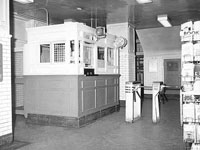
The interior of the Jarvis station house is seen in 1971. The original appointments are all still largely intact and in good condition, including the original ticket agent's booth and wall tiling. For a
larger view, click here. (CTA photo, Graham Garfield Collection) |
The interior was rendered in plaster, wood, glazed brick, and
brick with terrazzo floors. There were arches stretching across the
interior between the support columns. In the center of the interior,
passengers found a decorative wooden ticket agent's booth with
ornamental woodwork and a metal grille over the ticket agent's
window. The station also had public restrooms.
There were four tracks through Jarvis station, but the outer two tracks were for express trains and were not served by the station. A single island platform between the two center tracks served local trains. The platform
had wood decking and a canopy with metal columns down the center line
which split into gently-curving gull wing-shaped roof supports,
supporting a wooden canopy roof. The stairs were sheltered by wooden
enclosures with wooden bottoms and windows on top, divided into rows
of square panes, with swinging doors at the front of each enclosure. Like most of the stations north
of Lawrence, there was originally an
auxiliary exit on the north side of the street, descending down in
the middle of retail spaces built under the elevated, now closed.
In December 1920, it was reported that the Jarvis station, along with Argyle, Edgewater Beach, Bryn Mawr, Thorndale, and Granville, would be completed by late Spring 1921.6 By
early 1922, the new four track mainline was completed, allowing full
express service to the city limits.
In 2006, the station name signs and column signs on the platform
were replaced, with Green Line
Graphic Standard signs replacing the KDR
Standard graphics, and new entrance signs installed as part of a
signage upgrade project on the Red Line. As part of this effort, the
station also received granite compass roses inset into the sidewalk
in front of the station entrance to assist customers leaving the
station to navigate their way, and three-sided galvanized steel
pylons in the station house and on the platform to display maps and
station timetables.
In 2008, the canopy at Jarvis was refurbished. The roof was
removed and replaced with a new corrugated metal top. The metal
canopy supports were stripped and repainted. New lighting was also
installed as part of the renovation.
North Red Line Life-Extension Renovations
By the early 21st century, the stations, track, and elevated infrastructure on the north Red Line, between Wilson and Howard, were in severe need of rehabilitation, both to maintain a good state of repair as well as to modernize certain systems and amenities. The scale of the work and the funding necessary to undertake it were large enough that a broad study and planning effort were needed to properly scope the work and apply for sufficient funding. While this study was undertaken, and due to the presumed amount of time it would take to complete the study, secure funding, and complete design engineering, the CTA felt it was necessary to undertake modest-scale renovations in the meantime to extend the life of the existing infrastructure.
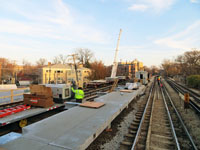
Crews are installing the new precast concrete deck panels on the far south end of the Jarvis platform, looking southeast on November 17, 2012. The right half of the platform has its panels, while the left side awaits its decking. The prefabricated panels are siting on a flatbed car, visible in the background. For a
larger view, click here. (Photo by Graham
Garfield) |
On February 8, 2012, the Chicago Transit Board approved the awarding of a design/build contract to Kiewit Infrastructure Co. to rehabilitate seven rail stations on the North Main Line section of the Red Line: Jarvis, Morse, Granville, Thorndale, Berwyn, Argyle and Lawrence. The work would provide a life-extension for the seven stations until a long-term capital improvement plan is determined for this portion of the Red Line as part of the Red-Purple Modernization Project (see below). "These interim improvements are important because we cannot postpone repairs which need our immediate attention. The CTA wants to be good stewards of the infrastructure we have now, as we continue to plan for the future and pursue additional funding," said CTA President Forrest Claypool. "This contract will allow us to quickly address some much needed capital maintenance work, while also improving the quality and experience for our riders and neighbors."
Kiewit Infrastructure Co. was awarded the contract to through a competitive bid process. Design work began in Spring 2012. Per the terms of the contract, construction was to conclude in early 2013 (though most work was actually completed by the end of 2012) and was not to exceed $57.4 million for services, labor and materials.
Construction plans included temporary station closures for no more than six weeks. Adjacent stations were not closed simultaneously. To minimize impact to customers, service reroutes were scheduled for overnight and weekends only.
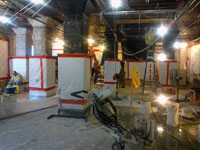
The interior of the Jarvis station house is seen during renovation construction, looking south on November 28, 2012. The interior has been stripped to its structural shell and work to build it back out is underway. The new glazed tile cladding is on the columns, wrapped in plastic to protect it while work continues. For a
larger view, click here. (CTA photo) |
Improvement work at each location included renovations to the station facilities, the viaduct, and the tracks. The station houses received new windows, doors and exterior lighting; exterior tuck pointing; improved station layouts; new turnstiles; new interior finishes, including new wall tiling, floors, walls and ceilings; new signage and interior lighting; and site improvements including sidewalk repairs and new bike racks. The platform deck structure and foundation was replaced, the platform fixtures, furnishings and canopy improved, and a new customer communication system installed. Concrete repairs to the viaducts and to the track-level walls were made at each station, and a new waterproofing and drainage system was installed. In addition, the viaducts received painting/coating and new, brighter lighting under the viaducts. New track, ties, and ballast was laid through the station area.7
The exterior masonry, including the brick walls and concrete trim, was cleaned and the brickwork re-tuckpointed. The wooden door and window frames were removed and a new dark brown aluminum storefront installed. New globed lights were installed on the piers.
Inside, the station house was gutted down to the structural shell. The retail space to the west of the station house was retained as rental space, but the retail space flanking the station to the east was demolished and the common wall removed so that the station interior could be expanded into the former concession space. The enlarged station interior allowed for a more open space and improved passenger circulation. The Transit Information Board, space for vending machines, and an employee restroom were installed in the former east retail space. The reconfiguration of the interior had the net effect of nearly doubling the floor space of the station's unpaid area. Although the west retail space was retained, the storefront windows inside the station, between the retail space and the station interior, were removed and replaced with a solid wall.
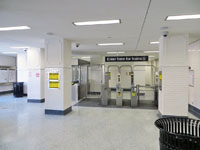
The interior of the renovated Jarvis station is seen looking southeast in the unpaid area on December 14, 2012. The rehabilitation gutted the interior and installed new terrazzo flooring, wall tiles, cement plaster walls and ceiling, lighting, and fixtures. The floor space was also expanded into adjacent former retail spaces -- the area on the left where the trashcan and information panel are located was formerly separate retail space. For a
larger view, click here. (Photo by Graham
Garfield) |
The interior walls were clad in new white modular glazed brick similar to the original material, though with some difference -- while the walls were originally clad only to a height just over 6 feet from the floor with plaster walls and ornamental trim above, nearly all of the renovated station interior's walls were clad in glazed brick up to the new suspended plaster ceiling. Only the free-standing columns, the rear angled wall under the north stairs to the platform, and certain piers along the side walls retained the original design of glazed brick extended up to a height of 6 feet, topped with a rounded bullnose trim, and cement plaster coating the walls above. In addition, the original ornamental plaster trim on the plaster walls was replicated on the free-standing columns and on the walls under and around the stairs -- while Thorndale and Berwyn both also had the trim replicated around the stairs, Jarvis was the only station of the seven renovated to have it replicated on the columns as well. In addition, the decorative tan art marble piers with ornamental Prairie School capitals that flank the front doors inside the station were retained and refurbished and the original cast iron newel posts at the bottom of the stair railings were kept. A new light gray terrazzo floor with dark gray edges along the walls was installed on top of a sand cushion, and a new plaster ceiling installed with recessed lighting. A new Customer Assistant kiosk was also installed, typical of those installed by the CTA at new Brown Line stations and other recent projects like the renovations at North/Clybourn and Cermak-Chinatown, with stainless steel lower walls and roof and glass panels on all side for maximum visibility. The new CA booth was roughly in the same location as the old one, moved about three feet east.
The wooden platform deck was completely removed and new foundations and supports installed to supplement the original structure. A new precast concrete deck was installed, edged with blue tactile panels. The original 1921 platform canopy was retained, stripped, rehabilitated, and repainted. The canopy roof installed in 2008 was retained. New fixtures including galvanized steel windbreaks and stairway enclosures, new benches, lighting, sandboxes, speakers, and signage were installed.
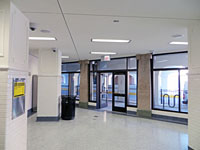
While the Jarvis station interior was largely completely rebuilt with new materials and reconfigured, a number of historic elements were retained or replicated. The decorative tan art marble piers with ornamental Prairie School capitals that flank the front doors were retained and refurbished, and the columns were re-tiled and ornamental trim replicated in a manner very close to the original designs. For a
larger view, click here. (Photo by Graham
Garfield) |
To improve the station's visibility, station "identifiers" were included in the project. Mounted to the bridge over the street, each identifier includes a large CTA logo centered on a horizontal pole to attract attention from afar and provide remote identification of the station's location -- akin to the famous roundel that marks the entrance to London Underground tube stations. The CTA logo is flanked by a train symbol, denoting the transit services available at the station.
Installing elevators to make all the stations wheelchair-accessible is not part of the short-term project.8 Work is also planned for the roofs of adjacent station buildings, so that inside concession spaces can be leased and begin to generate revenue for the Authority.9
Jarvis closed for renovation at 10pm, November 1, 2012, over a week earlier than the originally-planned November 9 closure date. The work was moved up to allow the contractors to complete the new platform installation before Thanksgiving, avoiding the need to reroute trains and impact service at Jarvis and Morse during the holiday weekend, and to reduce the risk of weather-related construction delays, whose likelihood increases the later work extends into the winter season. 10 The station reopened following renovation at 10pm, Thursday, December 13, 2012.
Funding for the station rehabilitation project is from the Federal Transportation Administration (FTA) and is part of the $1 billion Red Line investment project. The $1 billion capital investment is a combination of state, local and federal funds, which will support other Red Line projects including track and station renewal along the Dan Ryan branch; the renovation of the Clark/Division and Wilson stations; and several other track, substation and station renewal projects along the North Side Main Line.
Red-Purple Lines Modernization (RPM) Project
Due to the deteriorating condition of the infrastructure on the Red Line north of Belmont and on the Purple Line, the CTA initiated the Red-Purple Modernization Project (RPM) to bring the existing transit stations, track systems, and structures into a state of good repair. The project, which stretches along the existing Red and Purple lines from north of Belmont station to Linden terminal, would help bring the existing transit line into a state of good repair, reduce travel times, improve access to job markets and destinations, and provide improved access to people with disabilities.
The project began in 2009 with a vision study to assess the scope of needs and develop a set of alternatives for study. In 2010, in accordance with the National Environmental Policy Act (NEPA), CTA and Federal Transit Administration (FTA) initiated the environmental review process for the project and undertook work to develop an Environmental Impact Statement (EIS). The process included numerous public meetings and input opportunities, and study of various alternatives for achieving a good state of repair for the infrastructure in the project area.
A number of alternatives are under consideration for the RPM project, including the comprehensive reconstruction of track, stations, and structures along the line. The four options currently under consideration and study, not including an FTA-required "no action" baseline scenario, include:
- Basic Rehabilitation: provides a strategic mix of repairs, rehabilitation, and replacement of the existing infrastructure for a useful life of 20 years, plus the addition of a transfer station at Loyola; all station locations remain the same.
- Modernization with Station Consolidation: provides a brand new elevated structure between Lawrence and Howard, modern amenities at stations, increases speed of service, includes new transfer station at Loyola, and major reconstruction and renovation to extend the useful life to 60-80 years; several stations would be consolidated by closing one station and adding a second entrance at an adjacent station.
- Modernization without Station Consolidation: provides a brand new elevated structure between Lawrence and Howard, modern amenities at stations, modest increase in speed of service, includes new transfer station at Loyola, and major reconstruction and renovation to extend the useful life to 60-80 years; all station locations remain the same.
The Modernization with Station Consolidation option includes the consolidation of Jarvis and Howard stations by closing the existing Jarvis station and adding a new entrance to Howard at Rogers Avenue, approximately two blocks north of Jarvis station.
Other alternatives considered earlier in the study but subsequently eliminated due to public comment and further study included basic rehabilitation without adding a transfer station at Loyola, a modernization option with only three tracks between Lawrence and Howard, and a modernization option with a 2-track subway under Broadway.
The full-scale modernization envisioned on the Red-Purple Modernization Project could cost anywhere from $2.5 to $5 billion. On February 8, 2012, the CTA board retained Goldman Sachs & Co. to lead the search for public-private partnerships to help finance the reconstruction, which has no firm date. Goldman Sachs will work with Chicago-based Loop Capital Markets LLC and Estrada Hinojosa & Co., but will accept no fee for the first year as it determines the ability to raise private capital.
See CTA's Red & Purple Modernization page for more information about the scoping and planning process, and the various alternatives being considered.
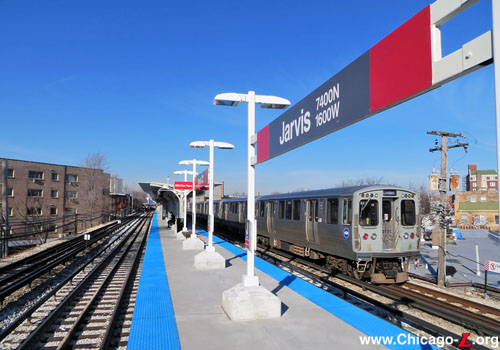
The renovated Jarvis station platform is seen looking northwest from the far south end on December 14, 2012, as a Linden-bound Purple Line Express train passes on the outside express track. The refurbished platform includes new precast concrete decking with tactile edging tiles, new free-standing light standards and luminaires outside of the canopy, and new signage. The large angled concrete bases where the light poles and canopy columns meet the new platform result from work to shore up the platform structure and create new support footings. For a larger view, click here. (Photo by Graham
Garfield) |

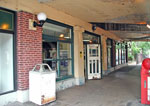 |
jarvis02.jpg (244k)
The Jarvis station entrance is seen looking southwest on July 14, 2005. The station remains largely intact in its original condition, including its original brick and cast stone details on the exterior. (Photo by Graham Garfield) |
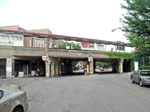
|
jarvis03.jpg (226k)
The early 1920s-built concrete viaduct carrying the "L" tracks and station platform and canopy are visible looking west on Jarvis Avenue on July 14, 2005. The station entrance (and the retail spaces flanking it) are on the left. (Photo by Graham Garfield) |
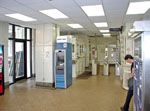
|
jarvis04.jpg (221k)
The interior of Jarvis station is seen looking southeast in the unpaid area on July 14, 2005. The ticket agent's booth, with its intricate wooden moldings and decorations, is original, now used by the Customer Assistant. The glazed tiles and decorative plasterwork on the walls is also original. The drop ceiling and concession booth (visible behind the farecard vending machine on the right) were added later, and removed circa 2008. (Photo by Graham Garfield) |
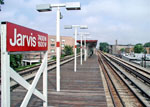 |
jarvis05.jpg (248k)
The island platform at Jarvis, looking northwest on July 14, 2005. The gull-wing canopy supports and roof structure in the background all date from the construction of the station in the early 1920s. (Photo by Graham Garfield) |
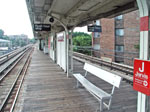
|
jarvis06.jpg (302k)
Jarvis station's island platform is seen looking
southeast on July 14, 2005 under the gull-wing canopy. (Photo by Graham Garfield) |
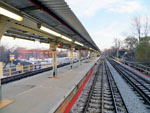 |
jarvis08.jpg (231k)
The new precast concrete platform is in place but a lot of work is still yet to be done to complete the refurbishment of the Jarvis station platform, looking southeast on November 17, 2012. (Photo by Graham Garfield) |
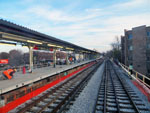 |
jarvis09.jpg (242k)
Construction workers are performing work to finish the installation of the new concrete deck panels, as well as other renovation and installation work, on the Jarvis station platform on the afternoon on November 18, 2012. (Photo by Graham Garfield) |
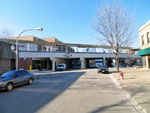 |
jarvis11.jpg (219k)
The "L" viaduct and Jarvis station are seen in the distance looking west on Jarvis Avenue on December 14, 2012. The concrete bridge deck spans supported by concrete piers on the sidewalk and in the center of the street are typical of the North Side track elevation completed in 1922. The Jarvis station platform is seen on top of the bridge, and the station house is on the left under the viaduct. A new viaduct-mounted CTA "identifier" provides clear remote identification of the station and the transit services available. Note that the module to the right of the CTA logo, which at other stations would contain a bus icon, is blank here, since only train service is available at Jarvis. (Photo by Graham Garfield) |
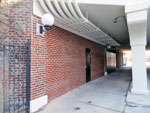 |
jarvis12.jpg (249k)
The former retail spaces under the viaduct on the north side of Jarvis Avenue, across from the station entrance, were bricked over in the renovation. The spaces have not housed concessions in decades, and for many years the space in the left (west) half, nearest the camera, had its storefront covered in a painted plywood wall with transom windows and a metal door, both covered in metal mesh grilles. That space housed a CTA Rail Instruction office and classroom for several years. The opening in the center, closed off by a black-painted plywood wall, originally led to auxiliary exit stairs from the platform. This view looks east on December 14, 2012. (Photo by Graham Garfield) |
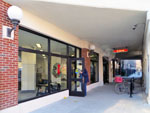 |
jarvis14.jpg (172k)
The front entrances of Jarvis station, looking west on December 14, 2012, the first full day the station was open after renovation. The windows and door in the foreground were previously a separate retail space adjacent to the station, now integrated into the expanded station house footprint. In the middle is the station's original entranceway, framed by the pair of white-painted Prairie School piers. In the background, the last bays of the front elevation are still a separate retail space, though it was unoccupied and still required interior build-out at the time of the station's reopening. (Photo by Graham Garfield) |
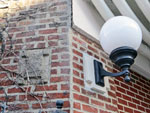 |
jarvis15.jpg (292k)
This detail view compares an original molded concrete light fixture base -- the material was referred to as "cast stone" in the original station drawings from 1921-22 -- to one of the recreated ones at the renovated Jarvis station, these being on the west elevation on the north side of Jarvis Avenue on December 14, 2012. As seen, the new light fixtures based are not accurate reproductions of the original ones. In fact, they invert the shape of the originals -- while both have a raised center, the originals had raised squares at the corners and depresses surfaces along the sides creating a sort of check pattern, whereas the new ones depress the corners and raise the middles of the sides creating more of a cross shape. The new pattern on the right is used at all the north Red Line stations renovated in 2012. (Photo by Graham Garfield) |
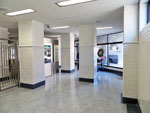 |
jarvis17.jpg (185k)
The interior of the renovated Jarvis station is seen looking northwest on December 14, 2012. This view is from the southeast corner of the expanded station interior in an area that was formerly part of an adjacent retail space. In the expanded station, this area is largely out of the general circulation area of the station, and leads to an employee restroom and storage room behind the photographer. Vending machines may eventually be placed in this area. The columns in this area and the rest of the interior were clad in new glazed tiles with a bullnose header and decorative moldings in the plaster surfaces above, recreating the look of the original interior finishes. The new Customer Assistant booth is visible on the left between columns. (Photo by Graham Garfield) |
 |
jarvis18.jpg (177k)
In the original 1921 station interior, the walls and columns were clad with white glazed brick to a height 6 feet off the floor, topped with a rounded bullnose header course. The remaining wall space to the ceiling was faced in plaster with decorative molding panels, with an 8-1/4" art marble molding along the floorline. As seen in this view looking west inside the Jarvis station house on December 14, 2012, the renovated interior mimics this design with new materials, but with some modifications. The columns in the station house are clad in materials and in a style very similar to those that were removed, with a new base molding of dark precast terrazzo and white glazed tile topped with a rounded bullnose trim course to a point just over 6 feet off the floor and cement plaster above, with the decorative moldings recreated. On the walls, however (visible in the background), the plaster course above the tiling was omitted and the new glazed tiles extend all the way to the ceiling. (Photo by Graham Garfield) |
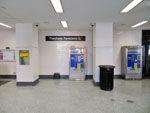 |
jarvis19.jpg (175k)
The west wall of the station interior is seen looking west on December 12, 2012. This was previously a storefront with large windows that looked into the adjacent retail space, but in the renovation the windows were removed and a new solid wall clad in white glazed tile installed to make the space more functional. The newly-created wall space was allocated for the farecard vending machines, which were previous clustered around columns (which made for poor queuing and circulation). A third space for a vending machine was soon filled by a machine for Ventra, CTA's new "open source" fare system. A doorway was still maintained between the station interior and the adjacent retail space, visible on the far right. (Photo by Graham Garfield) |
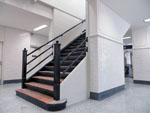 |
jarvis21.jpg (174k)
One of the portions of the renovated Jarvis station interior that maintained the original style of white tiled walls up to a six-foot height, topped with a bullnose trim, and ornamental trim in the cement-plaster walls above, were the walls on the sides and back of the north stairs up to the platform. The original cast iron newel posts at the bottom of the stairs and the original railings were also kept. The east side wall is seen looking northwest on December 14, 2012, the first full day the station was reopened for service. (Photo by Graham Garfield) |
 |
jarvis22.jpg (229k)
The renovated Jarvis station platform, seen looking southeast on December 14, 2012, retained the original canopy structure, rehabilitating and repainting the steel structure and retaining the new lights and canopy roofing installed in 2008. The bay where the center canopy supports give way to a pair of split supports shows where an auxiliary exit stairway originally descended to the street. A Linden-bound Purple Line Express train is heading up Track 4, the outside express track, on approach to Howard from the Loop. (Photo by Graham Garfield) |
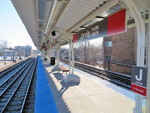 |
jarvis23.jpg (246k)
The Jarvis island platform, looking southeast on December 14, 2012, following renovation. The gullwing canopy is original to the 1921 station, but the recent rehabilitation replaced the wood platform deck with precast concrete, refurbished the canopy structure, and provided new platform signage and furniture. (Photo by Graham Garfield) |
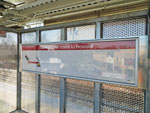 |
jarvis25.jpg (310k)
As part of the signage package for the renovated station, Jarvis received these smaller horizontal directional line diagram signs, one of the ones for the Howard-bound direction seen in a windbreak north of the stairs from the station house on December 14, 2012. The signs are similar to the horizontal diagrams found at certain subway stations, but are smaller to fit inside windbreaks. The signs provide wayfinding guidance to customers by providing a geographically-ordered list of all the stations between the current location and one of the terminals, supplementing the directional signs that only list the end terminal. This one, however, is somewhat (unintentionally) humorous-looking, since there is only one station beyond Jarvis in this direction. The line is kept short, rather than extending the width of the sign, to convey the idea that it is a relatively short distance, even though, strictly speaking, this is a diagram, not a map. (Photo by Graham Garfield) |
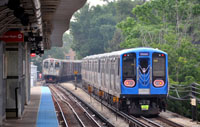 |
cta7007_20210723a.jpg (381k)
The prototype 7000-series cars are operating Purple Line Express run 515 the morning of July 23, 2021, as the train -- with car 7007 bringing up the rear -- passes Jarvis station on the express track. It will soon catch up with the 95th-bound Red Line train of predecessor 5000-series cars that just left the station. (Photo by Lou Gerard) |

|

|
Notes:
1. "An Early History of Birchwood Beach." Rogers Park / West Ridge Historical Society, retrieved 2012 February 11.
2. "ELEVATED MOVES BIRCHWOOD STATION TO CHASE AVENUE." Chicago Daily Tribune, 1915 July 1, pg. 1.
3. "Want Their Station Back." Chicago Daily Tribune, 1915 July 15, pg. 15.
4. "ELEVATED MOVES BIRCHWOOD STATION TO CHASE AVENUE," ibid.
5. "The Friend of the People.: JARVIS AVENUE--BIRCHWOOD." Chicago Daily Tribune, 1916 June 3, pg. 6.
6. "3 NEW STATIONS ON NORTH SIDE "L" READY JAN. 1." Chicago Daily Tribune, 1920 Dec. 1, pg. 21.
7. Red North Station Interim Improvements webpage. Chicago Transit Authority, retrieved 25 March 2012.
8. Hilkevitch, Jon. "$57.4 million facelift program OK'd for 7 North Side stops on CTA's Red Line." Chicago Tribune. 8 February 2012.
9. Roberts, Bob. "Major Renovations Coming To Multiple Red Line Stations." CBS Chicago. 9 February 2012.
10. "CTA to Close Glenwood Temporarily; Jarvis Station to Close Earlier than Planned". ward49.com. Posted October 24, 2012. Accessed October 26, 2012.






























